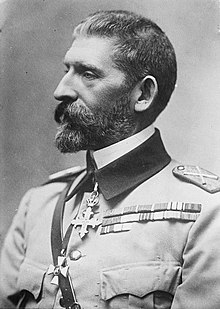
Back فرديناند الأول ملك رومانيا Arabic فرديناند الاول ملك رومانيا ARZ بیرینجی فردیناند (رومانی) AZB Фердынанд I (кароль Румыніі) Byelorussian Фердинанд I (Румъния) Bulgarian Ferran I de Romania Catalan Ferdinand I. Rumunský Czech Ferdinand 1. af Rumænien Danish Ferdinand I. (Rumänien) German Φερδινάνδος της Ρουμανίας Greek
| Ferdinand I | |||||
|---|---|---|---|---|---|
 Ferdinand in the 1920s | |||||
| King of Romania | |||||
| Reign | 10 October 1914 – 20 July 1927 | ||||
| Coronation | 15 October 1922 | ||||
| Predecessor | Carol I | ||||
| Successor | Michael I | ||||
| Born | 24 August 1865 Sigmaringen Castle, Sigmaringen, German Confederation | ||||
| Died | 20 July 1927 (aged 61) Peleș Castle, Sinaia, Kingdom of Romania | ||||
| Burial | Curtea de Argeș, Romania | ||||
| Spouse | |||||
| Issue | |||||
| |||||
| House | Hohenzollern-Sigmaringen | ||||
| Father | Leopold, Prince of Hohenzollern | ||||
| Mother | Infanta Antónia of Portugal | ||||
| Religion | Catholic Church | ||||
Ferdinand I (Ferdinand Viktor Albert Meinrad; 24 August 1865 – 20 July 1927), nicknamed Întregitorul ("the Unifier"), was King of Romania from 1914 until his death in 1927. Ferdinand was the second son of Leopold, Prince of Hohenzollern, and Infanta Antónia of Portugal, daughter of Ferdinand II of Portugal and Maria II of Portugal. His family was part of the Catholic branch of the Prussian royal family Hohenzollern.
In 1889, Ferdinand became Crown Prince of the Kingdom of Romania, following the renunciation of his father and older brother to the rights of succession to the royal crown of Romania. From the moment he settled in Romania, he continued his military career, gaining a series of honorary commands and being promoted to the rank of corps general. He married in 1893 Princess Marie of Edinburgh, granddaughter of both Queen Victoria and Emperor Alexander II.
Ferdinand became King of Romania on 10 October 1914, under the name Ferdinand I, following the death of his uncle, King Carol I. He ruled Romania during World War I, choosing to side with the Triple Entente against the Central Powers. This led to Kaiser Wilhelm II of Germany removing his name from the royal house of Hohenzollern. At the war's end, Romania emerged as a much-enlarged kingdom due to Bessarabia, Bukovina and Transylvania and parts of Banat, Crișana, and Maramureș becoming part of the Kingdom of Romania in 1920, and Ferdinand was crowned king of "Greater Romania" in a grand ceremony in 1922. In the years following the establishment of Greater Romania, Romanian society went through a series of major transformations, especially to the application of the agrarian reform and of the universal vote. In 1925, his eldest son, Prince Carol, gave up the rights of succession to the royal crown of Romania leading to a dynastic crisis, as the next prince in line of succession was Carol's 4-year-old son, Prince Michael. This led Ferdinand to remove Prince Carol's name from the royal house of Romania.
Ferdinand died from cancer in 1927 and was succeeded by his grandson Michael under a regency formed by three people: Prince Nicholas of Romania, the younger brother of Prince Carol; patriarch Miron Cristea; and president of the Supreme Court of Justice Gheorghe Buzdugan.
© MMXXIII Rich X Search. We shall prevail. All rights reserved. Rich X Search